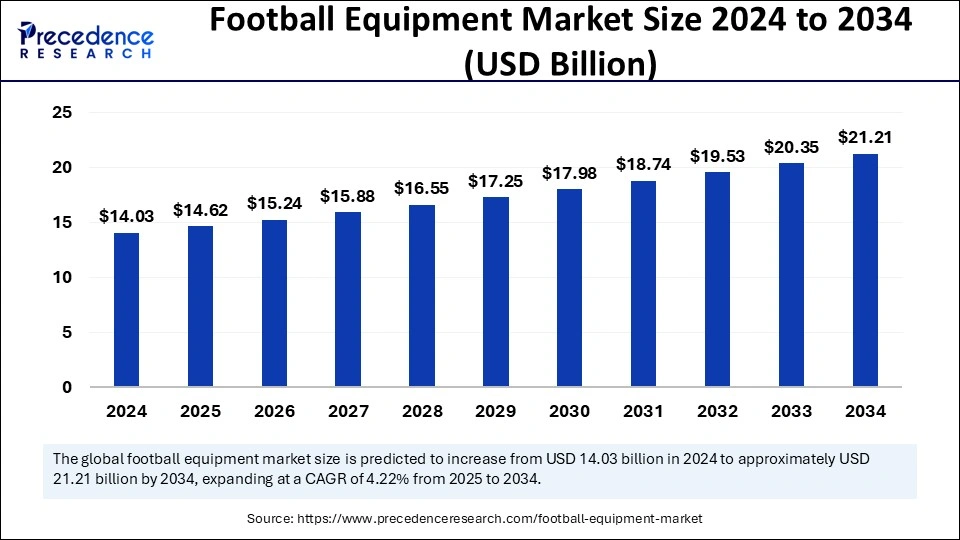The global football equipment market is projected to grow from USD 14.03 billion in 2024 to USD 21.21 billion by 2034, registering a CAGR of 4.22%.

Football Equipment Market Key Takeaways
- North America dominated the global market with the largest share of 36% in 2024.
- Europe is expected to witness the fastest growth in the coming years.
- By product type, the football segment contributed the highest market share in 2024.
- By product type, the footwear segment is expected to grow at the fastest CAGR between 2025 and 2034.
- By material, the leather segment captured the biggest market share in 2024.
- By material, the synthetic segment is likely to witness notable growth during the forecast period.
- By distribution channel, the offline segment generated the major market share in 2024.
- By distribution channel, the online segment is anticipated to expand at the fastest CAGR between 2025 and 2034.
- By end-user, the professional players segment held the largest market share in 2024.
- By end-user, the youth players segment is projected to grow at a considerable CAGR during the projection period.
Market Overview
The Football Equipment Market has experienced significant growth in recent years, driven by the increasing global popularity of the sport. Football, known as soccer in some regions, continues to dominate as the most-watched and played sport worldwide. The demand for football gear, including jerseys, cleats, balls, shin guards, gloves, and protective equipment, is rising as participation expands at both amateur and professional levels.
Major tournaments such as the FIFA World Cup, UEFA Champions League, and domestic leagues fuel market demand, while technological advancements in equipment manufacturing enhance player performance and safety. With the growing emphasis on youth sports development programs and government initiatives to promote physical activity, the market is expected to maintain a steady growth trajectory.
Drivers
One of the key drivers of the Football Equipment Market is the surge in grassroots and youth football programs worldwide. The increasing involvement of children and young adults in organized football has led to greater demand for training and protective gear. Sponsorships and endorsements by professional players and teams further fuel consumer interest, influencing purchasing behavior.
Additionally, advancements in materials and design have led to the development of lightweight, high-durability equipment that enhances player agility and comfort. The rise of e-commerce and online retail platforms has also played a crucial role in increasing accessibility to premium football gear across various regions.
Opportunities
The market presents significant opportunities in the integration of smart technology with football equipment. Innovations such as sensor-embedded footballs, performance-tracking wearables, and AI-driven coaching tools are gaining traction among professionals and amateur athletes. Sustainable and eco-friendly materials in football manufacturing are another key area of opportunity, as brands shift toward reducing their environmental footprint. Emerging markets in Asia, Africa, and Latin America also offer lucrative prospects for football equipment manufacturers, as increasing disposable incomes and improved sports infrastructure encourage greater participation in the sport.
Challenges
Despite its positive growth, the Football Equipment Market faces challenges such as price sensitivity among consumers, particularly in developing regions. High-quality football gear can be expensive, limiting accessibility for amateur players and schools with limited budgets. Counterfeit products pose another challenge, as the market is flooded with low-cost imitations that compromise safety and performance. Additionally, the risk of injuries in football, including concussions and fractures, has led to concerns over the effectiveness of protective equipment, pressuring manufacturers to enhance safety standards and regulatory compliance.
Regional Insights
Europe leads the Football Equipment Market, with strong demand stemming from countries with well-established football leagues such as England, Germany, Spain, and Italy. North America has seen growing interest in football, particularly in the United States, where Major League Soccer (MLS) expansion and youth soccer programs have increased demand for equipment.
The Asia-Pacific region is experiencing rapid market growth, driven by China, Japan, and India, where football is gaining popularity. Latin America remains a key market, particularly in Brazil and Argentina, where football is deeply ingrained in the culture. Africa is emerging as a potential growth hub due to increasing investments in football infrastructure and talent development.
Recent Developments
Recent innovations in football equipment include the launch of smart football boots equipped with motion sensors to analyze player movements and enhance training efficiency. Leading brands have introduced eco-friendly footballs and jerseys made from recycled materials, aligning with sustainability goals.
Collaborations between sportswear companies and top football clubs continue to shape market trends, with exclusive product launches and limited-edition gear gaining popularity. The industry has also witnessed a rise in digital marketing strategies, including virtual try-on features and AI-driven personalization, to enhance the consumer shopping experience.
Football Equipment Market Companies
- Under Armour
- Joma
- New Balance
- Kelme
- Kappa
- Adidas
- Nike
- Umbro
- Lotto
- Mizuno
- Diadora
- Hummel
- Grand Sport
- Puma
- Asics
Segments Covered in the Report
By Product Type
- Football
- Footwear
- Protective Gear
- Training Equipment
- Accessories
By Material
By Distribution Channel
- Online
- Offline
- Sports Stores
- Wholesale
By End-user
- Professional Players
- Amateur Players
- Youth Players
- Coaches
- Clubs
By Region
- North America
- Europe
- Asia Pacific
- Latin America
- Middle East and Africa
Ready for more? Dive into the full experience on our website!
